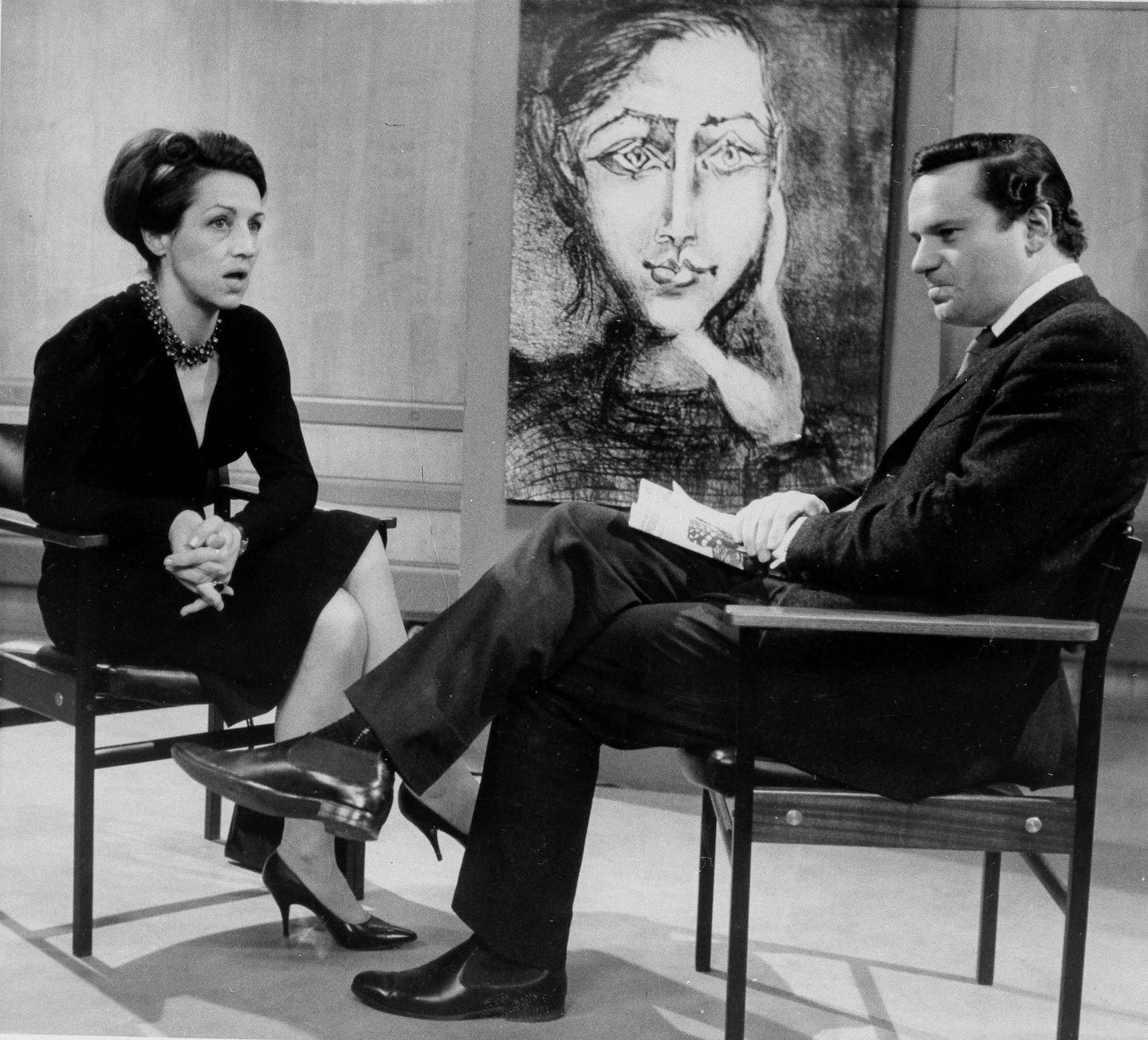Françoise Gilot, celebrated artist, writer and muse to Picasso, dies at 101
Listen 9 min Gift Article Share
Françoise Gilot had just finished dinner at Le Catalan, a Left Bank bistro in Paris, when Pablo Picasso approached her table with a bowl of cherries. He was 61, a master artist who had already reinvented himself several times over. She was 21 and, like the friend accompanying her that night in May 1943, starting out as a painter.
“That’s the funniest thing I’ve heard all day,” Picasso told the two elegant young women upon learning they were artists. “Girls who look like that can’t be painters.”
In fact, Ms. Gilot’s work had just appeared in an exhibition for the first time; one of her canvases was a veiled swipe at the city’s Nazi occupiers, showing a taxidermied hawk with the Eiffel Tower rising in the background. She would continue to paint through the tumultuous years that followed, as she became Picasso’s mistress, model and muse, the mother of two of his children and, by his account, the only woman who ever left him.
Advertisement
Ms. Gilot, who was 101 when she died June 6 at a hospital in Manhattan, achieved a distinguished career as a painter, with her work shown at the Metropolitan Museum of Art, Museum of Modern Art and Centre Pompidou in Paris.
She also published graceful, incisive memoirs and poetry collections, even as she spent decades battling with those who sought to define her by the men in her life, including Picasso, her friend Henri Matisse and her second husband, American virologist Jonas Salk, who helped eradicate polio.
Those men certainly influenced and inspired her, Ms. Gilot said. But there was no reason to view her as a supporting figure rather than a leading one. “Lions mate with lions,” she told Mirabella magazine. “They don’t mate with mice.”
The only child of a wealthy agronomist, Françoise Gilot was born in the Paris suburb of Neuilly-sur-Seine on Nov. 26, 1921. As a child, she borrowed paintbrushes from her mother, a homemaker who worked with watercolors and ceramics. Her father, who pined for a son and dressed Ms. Gilot in boys’ clothing, pushed her toward international law.
Like Picasso, her father “expected brilliance and obedience,” as Ms. Gilot put it. He forced her to swim and to jump from high places, to help her overcome a fear of water and heights. Although she was left-handed, he insisted that she learn penmanship with her right, leading her to become ambidextrous. To develop a sense of discipline, he suggested she follow a rigorous daily schedule: eight hours of legal studies and eight more of painting, plus “two hours for physical exercise and five hours for sleep.”
Advertisement
Ms. Gilot graduated from the Sorbonne at 17, in 1938, with a bachelor’s degree in philosophy. She was studying law when the Germans invaded France in 1940. “After that,” she told TV interviewer Charlie Rose, “I thought, ‘Well, you know, I don’t know how long we will remain alive. So I’m going to do what I want.’”
She dropped out of law school at the Sorbonne, an event that marked the beginning of a years-long estrangement from her father, and was studying at the Académie Julian art school when she began visiting Picasso’s studio in 1943 after their initial encounter at the bistro. By then, Picasso had separated from his first wife, Russian dancer Olga Khokhlova, and taken up with photographer Dora Maar. He soon abandoned her for Ms. Gilot.
Their relationship, she wrote in a best-selling memoir, “Life With Picasso” (1964), was “a catastrophe I didn’t want to avoid” — a passionate romance that was intellectually and artistically fulfilling but marred by episodes of physical and emotional abuse.
The couple lived together for nearly a decade, spending much of their time at a Riviera villa known as La Galloise, where Picasso introduced Ms. Gilot to friends including the existentialist philosophers Jean-Paul Sartre and Simone de Beauvoir, the filmmaker and artist Jean Cocteau, and the painters Georges Braque and Matisse.
The latter “acted like a visa on my passport to the realm of art,” Ms. Gilot said. Enchanted by her elegant figure (he likened her eyebrows to a pair of circumflex accents), Matisse said he would be delighted to make a portrait of her, Ms. Gilot recalled, “in which my hair would be olive green, my complexion light blue, and in which of course he could not forget the angle of my eyebrows in relation to my nose.”
Advertisement
Picasso, apparently irked by the possibility that someone else might paint his mistress, made the portrait himself in 1946, adopting Matisse’s proposed color scheme in a work he titled “La Femme-Fleur.”
He later incorporated Ms. Gilot and their two children, Claude and Paloma, into sculptures, paintings, ceramics and lithographs. But Ms. Gilot’s own work drew more from Matisse, whose brightly colored, emotionally reserved style she preferred over Picasso’s expressionistic technique. When their work was exhibited together in 2012 at the Gagosian Gallery in Manhattan, Picasso biographer John Richardson declared that “Picasso took from her rather more than she took from him.”
Reviewing her 1965 solo exhibition at the Findlay Gallery in Manhattan, New York Times art critic Stuart Preston wrote that Ms. Gilot “is an artist very much in her own right … Without any self-indulgent interest in sensuous or ‘interesting’ textures, she has a feeling for the quality of paint itself and for the mysteriously effective relationship of color and shape that lends her paintings, large and small, a genuinely authoritative air.”
Ms. Gilot’s independent spirit eventually drew the ire of Picasso, who declared that women were “either goddesses or doormats.” In the midst of an argument, he held a lit cigarette to her cheek. “He must have expected me to pull away,” she wrote, “but I was determined not to give him the satisfaction.”
On another occasion, she said he pointed to a waste pile in his studio and told her, “You don’t count any more for me than that dust there.” She replied: “The difference is that I’m the kind of dust that doesn’t like being swept out — the kind that will leave when it wants to.”
Advertisement
When they finally separated, in 1953, Ms. Gilot said Picasso sought to take his revenge by sabotaging her art career, persuading some galleries not to exhibit or sell her paintings. He had less success trying to suppress the publication of her memoir, suing three times in a failed attempt to block its release.
Written with American art critic Carlton Lake, the book featured direct quotations of Picasso discussing his life and work, rendered from Ms. Gilot’s memory and supported, Lake said, by letters and other documents from their time together.
Picasso supporters attacked the book, calling it libelous and vindictive. But it has since become a standard reference work for critics and scholars, hailed by one Times reviewer as “a vivid portrait of a monstrously difficult man and a brilliant depiction of a great artist at work.”
Advertisement
Its release effectively severed the ties between Ms. Gilot and Picasso, who married Jacqueline Roque in 1961 and reportedly barred Claude and Paloma from his home. After he died, in 1973, Ms. Gilot helped wage a legal battle to secure a portion of his estate for her children.
By then she had married and divorced Luc Simon, a French artist she had known since her student days; she often called it her second marriage, in a nod to the intensity of her relationship with Picasso.
In 1970, she married Salk, perhaps the most famous physician in the world for his work on polio two decades earlier. He was running a lab in San Diego when a mutual friend introduced him to Ms. Gilot. Salk knew next to nothing about painting; she knew little of science. But Ms. Gilot said her interest was piqued after he invited her to tea and ordered pistachio and tangerine ice cream.
Advertisement
They bonded over a shared interest in modern architecture, and she agreed to marry him six months later. The couple remained together until his death in 1995. Through an arrangement that enabled both of them to focus on their work, they spent half the year apart, with Ms. Gilot working from studios in New York and Paris. She sometimes painted in a Salk Institute lab coat, according to People magazine.
Asked to compare her two famous companions, Ms. Gilot declared that “in Jonas Salk, the man is equal to the artist. Picasso, the man, was not on the same level as Picasso, the artist.” She said she eventually sold all the Picasso works she owned, including “La Femme-Fleur,” because of the “bad luck” that seemed to trail him — including, she noted, the suicides of his mistress Marie-Thérèse Walter, his wife Roque and his grandson Pablito.
Ms. Gilot chaired the fine arts department at the Idyllwild arts school at a time when it was affiliated with the University of Southern California. She also wrote books including “Matisse and Picasso: A Friendship in Art” (1990) and “About Women” (2015), with Lisa Alther, and was appointed an officer in France’s Legion of Honor in 2009.
In the years after Picasso’s death, Ms. Gilot’s son, Claude Picasso, became administrator of the artist’s estate. Her daughter Paloma Picasso worked as a fashion designer and created jewelry for Tiffany & Co. Ms. Gilot also had a daughter, Aurelia Engel, an architect who became curator of her mother’s archives, from her marriage to Simon.
Advertisement
Ms. Gilot had heart and lung ailments, Engel said. In addition to Engel, she is survived by her two other children and four grandchildren.
Despite losing vision in her left eye, she continued painting into her 90s, starting at dawn while wearing pajamas and slippers.
“If you want to really live, you must risk living on the edge; otherwise, life isn’t worth it,” she told journalist Malte Herwig for his 2016 biography, “The Woman Who Says No.” “When you open yourself to risk, you will also experience bad things, but mostly you will learn a lot and live and understand more and more. Most importantly, you will not be bored. The very worst thing is to be bored.”
GiftOutline Gift Article
Source: The Washington Post


